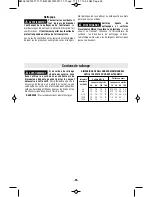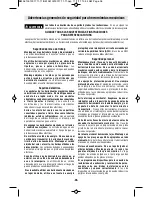
Service
Preventive maintenance
performed by unauth-
orized per so n nel may result in misplacing
of internal wires and components which
could cause serious hazard.
We
recommend that all tool service be performed
by a Bosch Factory Service Center or Autho -
rized Bosch Service Station.
TOOL LUBRICATION
Your Bosch tool has been properly lubricated
and is ready to use. It is recommended that
tools with gears be regreased with a special
gear lubricant at every brush change.
CARBON BRUSHES
The brushes and commutator in your tool
have been engineered for many hours of
dependable service. To maintain peak
efficiency of the motor, we recommend every
two to six months the brush es be examined.
Only genuine Bosch replace ment brushes
specially designed for your tool should be
used.
BEARINGS
After about 300-400 hours of operation, or at
every second brush change, the bearings
should be replaced at Bosch Factory Service
Center or Au thorized Bosch Service Station.
Bearings which become noisy (due to heavy
load or very abrasive material cut ting) should
be replaced at once to avoid overheating or
motor failure.
!
WARNING
Maintenance
SANDING WOOD
When sanding wood the direction of the disc
motion at the contact point should parallel the
grain as much as possible. The rapid cut of
discs and the swirl type scratch pattern they
occasionally create generally prohibit their
use for producing the final finish.
Scratches and circular marks are usually the
result of using too coarse a grit. When
changing to a finer grit, move across the
sand ing lines that were made by a previous
coarser disc.
SANDING METAL
When sanding automobiles or appliances,
wipe the metal clean with a non-flammable
solvent or commercial cleaner to remove all
wax and grease. By doing this first, the
sanding discs will sand better and last longer.
For heavy duty work, use a coarse grit disc
first. Follow-up with a medium grit to remove
scratches. To produce smooth finish, use fine
grit disc.
-12-
POLISHING TIPS
For the polishing of weathered paint or
buffing out scratches (e.g., acrylic glass), the
tool may be fitted with appropriate polishing
accessories such as lamb’s wool bonnet,
polishing felt or sponge (optional accessories).
Select a low speed for polishing (dial setting
1 – 2) in order to avoid excessive heating of
the surface.
Apply the compound to the surface, and use
the sponge applicator pad with light pressure
and a circular motion to remove scratches and
restore weathered finishes. Use only as much
compound as necessary, and clean the
sponge frequently during use.
When initial polishing is completed, wipe away
any excess compound with a soft towel, and
then polish the surface to its final finish with the
buffing pad. Use smooth overlapping strokes
for best results.
Clean the buffing pad and sponge applicator
pad with mild detergents and warm water. DO
NOT use solvents.
BM 2610019017 11-11:BM 2610019017 11-11.qxp 11/1/11 10:34 AM Page 12













































